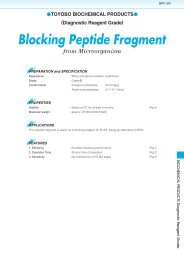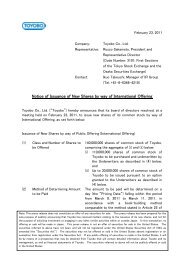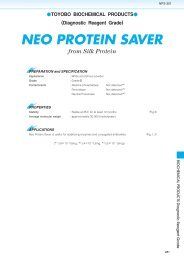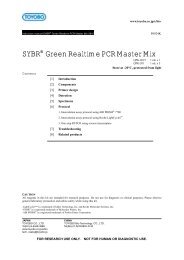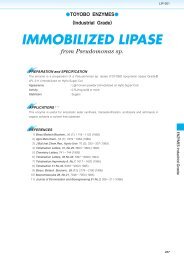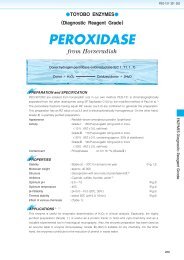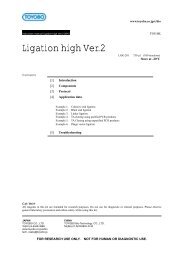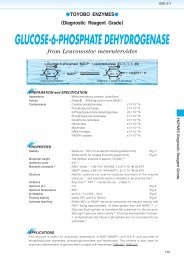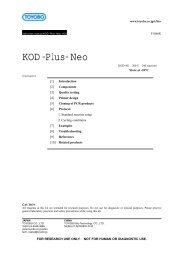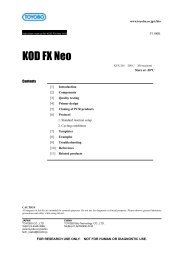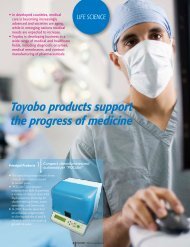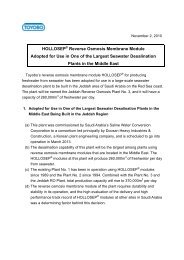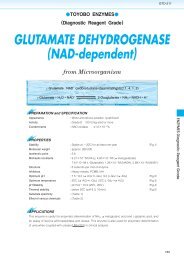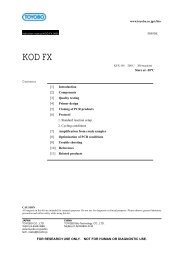ASCORBATE OXIDASE - Toyobo
ASCORBATE OXIDASE - Toyobo
ASCORBATE OXIDASE - Toyobo
- No tags were found...
You also want an ePaper? Increase the reach of your titles
YUMPU automatically turns print PDFs into web optimized ePapers that Google loves.
ASO-301<br />
TOYOBO ENZYMES<br />
(Diagnostic Reagent Grade)<br />
<strong>ASCORBATE</strong> <strong>OXIDASE</strong><br />
from Cucumis sp.<br />
L-Ascorbate: oxygen oxidoreductase (EC 1.10.3.3)<br />
L-Ascorbic acid 1 /2O 2<br />
Dehydroascorbic acidH 2 O<br />
PREPARATION and SPECIFICATION<br />
Appearance<br />
: Light blue amorphous powder, lyophilized<br />
Activity<br />
: Grade200U/mg-solid or more<br />
(containing approx. 70% of stabilizers)<br />
Contaminants : Catalase ≤1.010 1 %<br />
Phosphatase ≤2.010 2 %<br />
Stabilizers<br />
: Bovine serum albumin (BSA), borax, basic amino acids.<br />
PROPERTIES<br />
Stability : Store at 20 Fig.1<br />
(A decrease in activity of ca.20% may occur at 5 within 6 months.)<br />
Molecular weight<br />
: 132,000 1 , 140,000 2<br />
Isoelectric point<br />
: between 6.0 and 7.8 1 , 8.2 2<br />
Michaelis constant<br />
: 2.510 4 M (Ascorbate)<br />
Structure : 8 copper atoms per mol of enzyme 1,2<br />
Inhibitors<br />
: cyanide, Na 2 S, diethyldithiocarbamate (Na)<br />
Optimum pH : 5.6 Fig.3<br />
Optimum temperature : approx. 30 Fig.4<br />
pH Stability : pH 7.010.0 (25, 17hr) Fig.5<br />
Thermal stability : below 40 (pH 8.0, 30min) Fig.6<br />
Substrate specificity<br />
: This enzyme oxidizes ascorbic acid and several ascorbic derivatives. 3<br />
Effect of various chemicals : (Table 1)<br />
APPLICATIONS<br />
This enzyme is useful for enzymatic determination of ascorbic acid and for eliminating the interference<br />
of ascorbic acid in clinical analysis.<br />
25
ASO-301<br />
ASSAY<br />
Principle:<br />
Ascorbic acid 1 ascorbate oxidase<br />
/ 2 O 2<br />
Dehydroascorbic acidH 2 O<br />
The disappearance of ascorbic acid is measured at 245nm by spectrophotometry.<br />
Unit definition:<br />
One unit causes the decrease of one micromole of ascorbic acid per minute under the conditions described below.<br />
Method:<br />
Reagents<br />
A. Ascorbic acid solution 1.0mM Dilute the stock solution (10mM) to 10-fold volume with 0.2 M KH 2 PO 4<br />
solution containing 1.0mM EDTA.(Should be freshly prepared) Stock solution :<br />
176mg L-ascorbic acid (MW176.13)/100ml of 1.0mM HCl solution containing<br />
1.0mM EDTA (Stable for one month if stored at 05)<br />
B. Na 2 HPO 4 solution<br />
C. HCl solution<br />
D. Enzyme diluent<br />
10mM<br />
0.2N<br />
10mM Na 2 HPO 4 solution containing 0.05% BSA (Should be freshly prepared)<br />
Procedure<br />
1. Prepare the following reaction mixture in a test tube and<br />
Concentration in assay mixture<br />
equilibrate at 30 for about 5 minutes.<br />
KH 2 PO 4<br />
82 mM<br />
0.5ml Substrate solution (A) Na 2 HPO 4<br />
5.5 mM<br />
0.5ml Na 2 HPO 4 solution (B) Ascorbic acid<br />
0.45 mM<br />
(pH of the reaction mixture should be 5.6.)<br />
EDTA<br />
0.45 mM<br />
2. Add 0.1ml of the enzyme solution and mix.<br />
BSA<br />
45.4g/ml<br />
3. After exactly 5 minutes at 30, add 3.0ml of HCl solution (C) to stop the reaction and measure the optical<br />
density at 245nm against water (OD test).<br />
At the same time, prepare the blank by first mixing the reaction mixture with 3.0ml of HCl solution (C) after<br />
5 min-incubation at 30, followed by adding the enzyme solution (OD blank).<br />
Dissolve the enzyme preparation in ice-cold distilled water (more than 60U/ml) and dilute to 0.150.25U/ml<br />
with ice-cold enzyme diluent (D), immediately before assay.<br />
Calculation<br />
Activity can be calculated by using the following formula<br />
Volume activity (U/ml) <br />
OD (OD blankOD test)Vtdf<br />
10.01.0tVs<br />
OD0.820df<br />
Weight activity (U/mg)(U/ml)1/C<br />
Vt Total volume (4.1ml)<br />
Vs Sample volume (0.1ml)<br />
10.0 Millimolar extinction coefficient of ascorbic acid under the assay condition at pH 1.0<br />
(F/micromole)<br />
1.0 Light path length (cm)<br />
t Reaction time (5 minutes)<br />
df Dilution factor<br />
C Enzyme concentration in dissolution (c mg/ml)<br />
REFERENCES<br />
1) T.Nakamura, N.Makino and Y.Ogura; J.Biochem., 64, 189 (1968).<br />
2) V.Ts.Aikazyan and R.M.Nalbandyan; FEBS LETTERS, 104, 127 (1979).<br />
3) G.A.White and F.G.Smith; Nature, 190, 187 (1961).<br />
26
ASO-301<br />
Table 1. Effect of Various Chemicals on Ascorbate oxidase<br />
The enzyme dissolved in distilled water (60U/ml) was incubated with each chemical at 25 for 1hr.]<br />
Chemical<br />
None<br />
Metal salt<br />
MgCl 2<br />
CaCl 2<br />
Ba(OAc) 2<br />
FeCl 3<br />
CoCl 2<br />
MnCl 2<br />
ZnCl 2<br />
CdCl 2<br />
NiCl 2<br />
CuSO 4<br />
Pb(OAc) 2<br />
AgNO 3<br />
HgCl 2<br />
2-Mercaptoethanol<br />
PCMB<br />
Residual<br />
Concn.(mM)<br />
activity<br />
100%<br />
2.0<br />
2.0<br />
1.0<br />
88<br />
86<br />
86<br />
34<br />
83<br />
88<br />
90<br />
87<br />
79<br />
90<br />
91<br />
3.7<br />
42<br />
75<br />
26<br />
Chemical<br />
MIA<br />
NEM<br />
IAA<br />
Hydroxylamine<br />
EDTA<br />
o-Phenanthroline<br />
,-Dipyridyl<br />
Borate<br />
NaF<br />
NaN 3<br />
Triton X-100<br />
Brij 35<br />
Tween 20<br />
Span 20<br />
Na-cholate<br />
SDS<br />
DAC<br />
Concn.(mM)<br />
2.0<br />
2.0<br />
2.0<br />
2.0<br />
5.0<br />
2.0<br />
1.0<br />
50<br />
2.0<br />
2.0<br />
0.10%<br />
0.10%<br />
0.10%<br />
0.10%<br />
0.10%<br />
0.05%<br />
0.05%<br />
Residual<br />
activity<br />
3.5%<br />
75<br />
21<br />
81<br />
80<br />
50<br />
78<br />
75<br />
84<br />
85<br />
84<br />
24<br />
19<br />
97<br />
80<br />
83<br />
88<br />
Ac, CH 3 CO; PCMB, p-Chloromercuribenzoate; MIA, Monoiodoacetate; NEM, N-Ethylmaleimide; IAA, lodoacetamide;<br />
EDTA, Ethylenediaminetetraacetate; SDS, Sodium dodecyl sulfate; DAC, Dimethyl-benzyl-alkyl-ammonium-chloride.<br />
50<br />
Residual Activity,%100<br />
-20<br />
5<br />
Relative Activity<br />
100<br />
50<br />
50<br />
Residual Activity,%100<br />
0 1 2 3 4 5 12 0 3 4 5 6 7 8<br />
Period (months)<br />
pH<br />
Fig.1. Stability (Powder form)<br />
kept under dry conditions<br />
Fig.3. pH-Activity<br />
30 in 0.33 M buffer solution: pH3.0-6.0,<br />
acetate; pH5.0-8.0, phosphate<br />
0 3 6 9 12<br />
pH<br />
Fig.5. pH-Stability<br />
25, 17hr-treatment with<br />
Britton-Robinson's buffer<br />
50<br />
Residual Activity,%100<br />
5<br />
15<br />
30<br />
Relative Activity<br />
100<br />
50<br />
50<br />
Residual Activity,%100<br />
0 2 4 6 8<br />
Period (days)<br />
Fig.2. Stability (Liquid form)<br />
enzyme concn. : 8,000U/ml<br />
buffer composition : 45mM borate<br />
buffer,pH7.8<br />
0 30 40 50<br />
Temperature, <br />
Fig.4. Temperature activity<br />
in 0.33M phosphate buffer,pH5.6<br />
0 20 40 60<br />
Temperature, <br />
Fig.6. Thermal stability<br />
30min-treatment with 50mM<br />
phosphate buffer,pH 8.0<br />
enzyme concn.: 12U/ml<br />
27
ASO-301<br />
<br />
<br />
2<br />
ascorbate oxidase<br />
<br />
2 <br />
<br />
<br />
<br />
<br />
<br />
<br />
<br />
<br />
2 4 <br />
<br />
<br />
P<br />
<br />
2 4 <br />
<br />
<br />
P<br />
2 4 <br />
P<br />
<br />
<br />
<br />
P <br />
P 2 4 <br />
<br />
P<br />
P<br />
<br />
<br />
<br />
PP<br />
<br />
<br />
<br />
P<br />
P<br />
P <br />
<br />
P <br />
<br />
F<br />
<br />
P<br />
28



